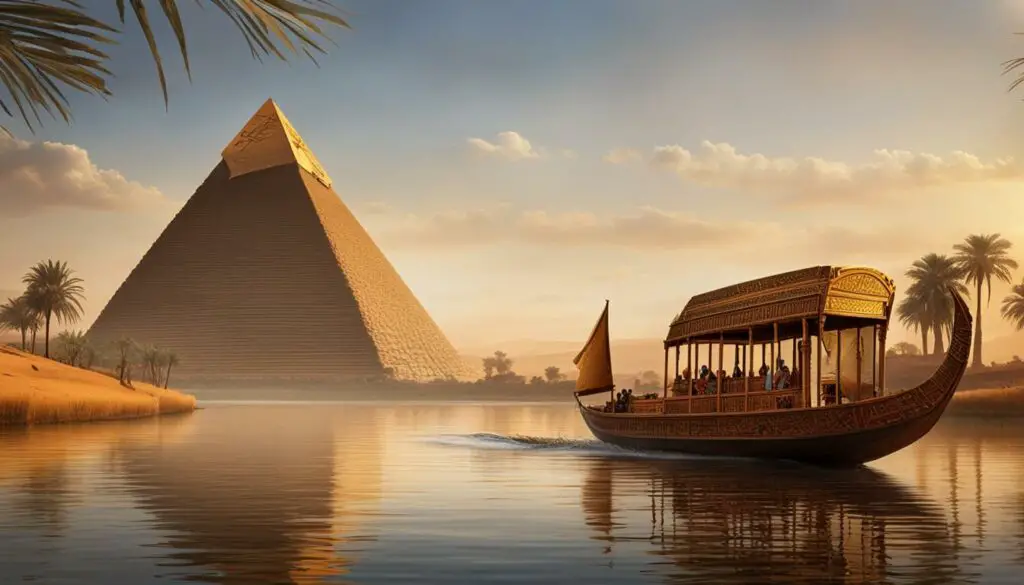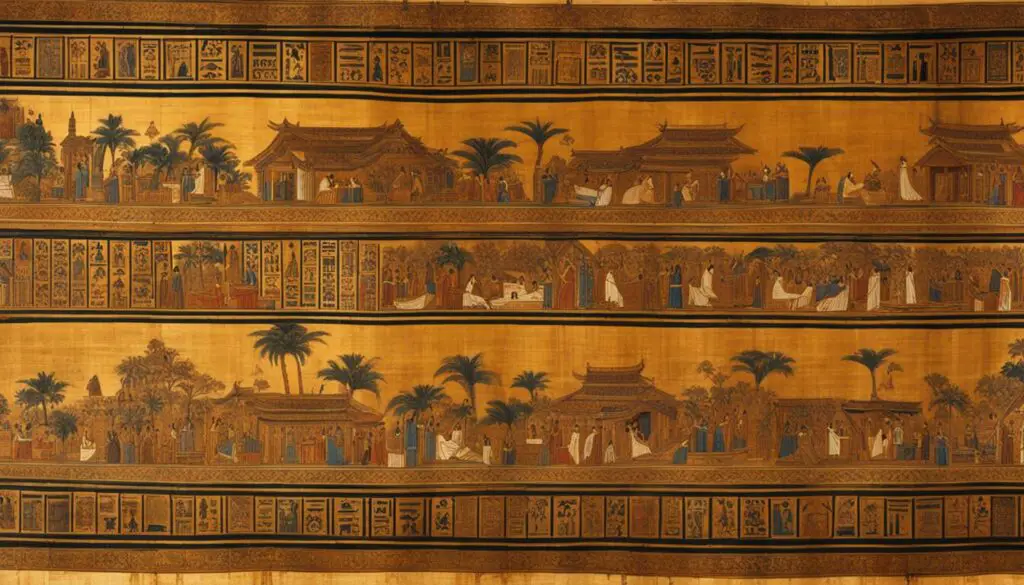Ancient Egyptian afterlife beliefs were deeply rooted in religion and shaped by various rituals and practices. The Egyptians held a strong conviction in the existence of an afterlife, a concept that closely mirrored the living world. Their beliefs centered around the idea of eternal life and the possibility of rebirth.
The Egyptians believed that upon death, the souls of the deceased would embark on a journey through the Duat, an underworld where they would continue their existence. This journey was fraught with encounters with gods, creatures, and gatekeepers who had to be appeased along the way.
Furthermore, the afterlife was seen as a reward for living a virtuous life and following religious customs and rituals. The deceased would have to plead their case and prove their innocence before Osiris, the god of the underworld, and 42 divine judges in the Hall of Final Judgment.
The heart of the deceased would be weighed against the feather of Ma’at, the goddess of truth and justice. If the heart was lighter than the feather, they would be granted entry into the afterlife. This belief in a final judgment and a blissful afterlife provided solace and comfort to the ancient Egyptians.
The Journey to the Afterlife
In ancient Egypt, the journey to the afterlife held great significance. It was believed that this journey began upon the death of an individual, as their soul embarked on a transformative path through the Duat, the underworld. Along the way, the deceased encountered gods, creatures, and gatekeepers, each playing a unique role in their ultimate destination.
The purpose of this journey was to reach the Hall of Final Judgment, where Osiris, the god of the underworld, awaited. Here, the deceased would face a crucial moment of reckoning, as they pleaded their case and strived to prove their innocence before the 42 divine judges. This process was a pivotal part of the ancient Egyptian burial customs, as it determined the fate of the deceased in the afterlife.

The final judgment centered around the weighing of the heart against the feather of Ma’at, the goddess of truth and justice. The heart, symbolizing the essence of the deceased’s integrity and righteousness, had to be lighter than the feather. If the heart passed this ultimate test and was deemed pure, the door to the afterlife would be open, granting the deceased eternal existence.
This transformative journey, rich in symbolism and profound beliefs, exemplifies the deep-rooted importance of afterlife rituals in ancient Egypt. It reflects the intricacies of their burial customs and the heartfelt belief in an eternal existence beyond the physical realm.
Funeral Practices in Ancient Egypt
In ancient Egypt, funeral practices played a crucial role in ensuring a successful afterlife. The Egyptians believed in the preservation of the body through the process of mummification, which prevented decomposition and ensured the survival of the individual in the afterlife.
The mummification process involved several steps, including the removal of internal organs, the drying of the body using natron (a type of salt), and the wrapping of the body with linen bandages. This meticulous process aimed to preserve the physical form and integrity of the deceased.
Funerary Practices in Ancient Egypt
| Funeral Practice | Description |
|---|---|
| Mummification | A process that involved removing the internal organs, drying the body with natron, and wrapping it in linen bandages. |
| Tomb Construction | Tombs, also known as “houses of eternity,” were built to protect the physical body and provide a resting place for the spirit of the deceased. |
| Decoration of Tombs | Tombs were adorned with religious texts, prayers, and images of gods and goddesses associated with death and the afterlife. |
The tombs themselves were carefully constructed structures designed to provide a place of eternal rest for the deceased. These tombs, commonly referred to as “houses of eternity,” were equipped with various chambers and passages to accommodate the various rituals and offerings made to the deceased. Tombs were often decorated with religious texts, prayers, and intricate images of gods and goddesses associated with death and the afterlife.
The funeral practices in ancient Egypt were deeply rooted in their religious beliefs, emphasizing the significance of a proper burial and preparations for the journey to the afterlife. These practices aimed to ensure the preservation of the physical body and provide a comfortable resting place for the spirit of the deceased in the eternal realm.
Funerary Texts and Amulets
Funerary texts and amulets played a significant role in ancient Egyptian burial customs. These sacred texts and charms were essential in providing guidance and protection for the deceased in their journey through the afterlife.
One of the most well-known funerary texts was the Egyptian Book of the Dead, which served as a guidebook for the deceased to navigate the challenges and obstacles they would encounter in the afterlife. This collection of spells and prayers was typically inscribed on papyrus or painted on tomb walls. The Book of the Dead contained instructions on how to transform into a divine being and obtain eternal life.
The Pyramid Texts and the Coffin Texts were other important funerary texts used during different periods of ancient Egyptian history. These texts were primarily reserved for royalty and the elite, providing them with specific rituals and magical formulas to secure a successful transition to the afterlife.
The Books of the Netherworld were also significant in ancient Egyptian funerary practices. These texts detailed the journey of the deceased through the underworld and provided instructions for navigating the spiritual challenges presented along the way. They served as a roadmap to the afterlife, ensuring the deceased would have the necessary knowledge to overcome various trials and reach their final destination.
Amulets were another essential component of ancient Egyptian burial customs. These small charms were often carved or shaped into symbolic forms and placed on various parts of the body to provide protection and aid the deceased in the afterlife. One notable amulet was the heartscarab, representing the heart of the deceased. It was believed to protect the heart during the final judgment and ensure its purity, as the heart was considered the seat of a person’s moral character.
Overall, the inclusion of funerary texts and amulets in ancient Egyptian burials was crucial in preserving traditions, guiding the deceased, and safeguarding their souls on their journey through the realm of the afterlife.

Preparations for the Afterlife
Preparations for the afterlife were of utmost importance in ancient Egypt, as they were believed to ensure a successful transition to the next realm. The ancient Egyptians firmly held the belief that proper preparations in life would guarantee a favorable outcome in the afterlife. These preparations involved both physical and spiritual aspects.
During their lifetime, individuals made careful arrangements for their departure by acquiring various funerary items and securing a suitable resting place for their physical remains. Funerary items, such as amulets and stelae, held symbolic significance and were meant to protect and guide the deceased in their journey beyond. The Book of the Dead, a compilation of spells and prayers, was regarded as a crucial companion, providing essential guidance and protection along the way.
One essential element of preparation was the acquisition or commissioning of a coffin. Coffins served as protective vessels for both the physical and spiritual bodies of the deceased, ensuring their safe passage into the afterlife. These coffins were expertly crafted, often adorned with intricate designs and hieroglyphs, depicting symbols and scenes associated with the journey to the beyond.
Furthermore, the construction of tombs played a pivotal role in the preparations for the afterlife. Tombs were carefully constructed, usually on the western bank of the Nile, symbolizing the connection to the setting sun and the realm of the dead. These tombs were meticulously designed to safeguard the physical remains and provide a sacred space for the spirits of the deceased to rest and receive offerings.
| Funerary Items | Coffins | Tombs |
|---|---|---|
| Amulets | Protection | Eternal resting place |
| Stelae | Guidance | |
| Book of the Dead |
In summary, preparations for the afterlife in ancient Egypt encompassed various components, including the acquisition of funerary items, the commissioning of coffins, and the construction of tombs. These preparations were considered fundamental in ensuring a favorable outcome in the afterlife and were guided by their deep-seated beliefs and customs.
The Role of Osiris and the Final Judgment
In ancient Egyptian afterlife beliefs, Osiris held a significant position as the god of the underworld. He was not only revered as the chief judge but also served as the guide for the deceased on their journey to the afterlife. Once the deceased reached the Hall of Final Judgment, they would stand before 42 divine judges and plead their innocence. However, the ultimate determination of their fate relied on the weighing of their heart against the feather of Ma’at, the goddess of truth and justice.
This ancient Egyptian final judgment symbolized the purification of the soul. If the heart proved lighter than the feather, it indicated that the deceased had lived a virtuous life adhering to the beliefs about death in ancient Egypt. Successfully passing this judgment meant being granted entry into the afterlife, where they would be warmly welcomed by Osiris himself.
Upon entering the afterlife, the deceased would discover the Field of Rushes, a reflection of the earthly world that awaited them. In this tranquil plane of existence, they would be able to continue their daily tasks and enjoy the comforts of eternal life. The deeply ingrained ancient Egyptian afterlife beliefs emphasized the importance of living a righteous life and following religious customs to ensure a favorable outcome in the final judgment before Osiris and a blissful eternity in the afterlife.
FAQ
What were the ancient Egyptian beliefs about the afterlife?
Ancient Egyptians believed in the existence of an afterlife that closely resembled the living world. They believed in eternal life and the possibility of rebirth. The afterlife was seen as a reward for living a virtuous life and following religious customs and rituals.
How did the journey to the afterlife in ancient Egypt begin?
The journey to the afterlife in ancient Egypt began with the death of an individual. The deceased’s soul would embark on a journey through the Duat, encountering gods, creatures, and gatekeepers along the way. The purpose of this journey was to reach the Hall of Final Judgment, where the deceased would face Osiris, the god of the underworld.
What were the funeral practices in ancient Egypt?
Funeral practices in ancient Egypt included the process of mummification, which involved preserving the body to prevent decomposition and ensure its survival in the afterlife. Tombs were carefully constructed to protect the physical body and provide a resting place for the deceased’s spirit. Funerary texts and amulets were also used to guide and protect the deceased in the afterlife.
What were funerary texts and amulets used for?
Funerary texts, such as the Book of the Dead, provided guidance and protection for the deceased in the afterlife. These texts contained spells and prayers to assist the deceased on their journey. Amulets, such as heartscarabs, were used to protect the deceased and ensure a successful afterlife. These charms were placed on various parts of the body and carried symbolic meaning associated with gods and goddesses.
What preparations were made for the afterlife in ancient Egypt?
Preparations for the afterlife in ancient Egypt were considered essential for a successful transition. The deceased would make preparations during their lifetime, including the purchase of small funerary items and commissioning or buying a coffin. Tombs were also carefully constructed on the western bank of the Nile to serve as the eternal resting place for the deceased.
Who was Osiris and what role did he play in the afterlife?
Osiris was the god of the underworld in ancient Egyptian mythology. He played a significant role in the afterlife as the chief judge of the underworld and the guide for the deceased on their journey. The final judgment involved standing before 42 divine judges and pleading innocence. If the deceased passed the judgment, they would be welcomed into the afterlife by Osiris.
